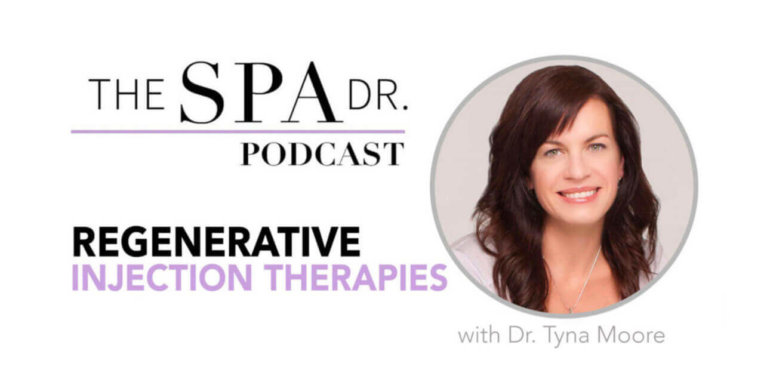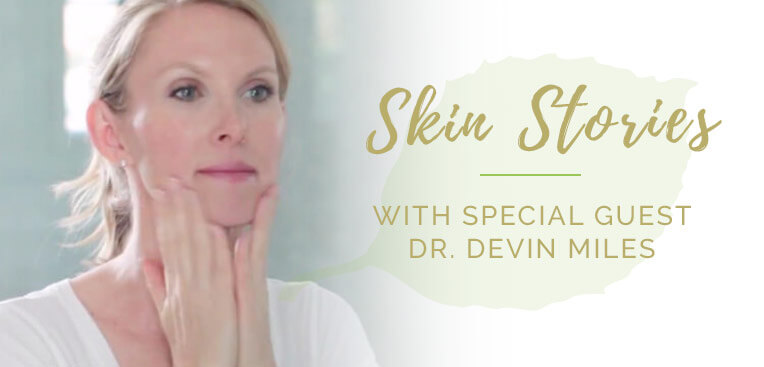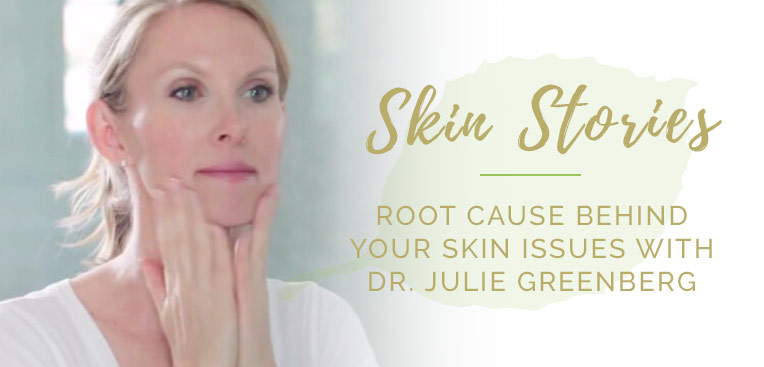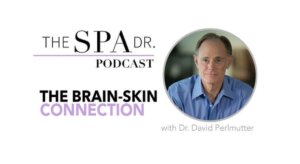As anti-aging medicine continues to increase in popularity, the number of options can be overwhelming and quite costly. On today’s podcast my guest shares her knowledge about regenerative injection therapies (including prolotherapy, PRP and stem cell injections) that are used to help with pain management as well as skin issues, including scarring and signs of aging.
My guest today is Dr. Tyna Moore. She is the Medical Director of Core Wellness Clinic in Portland, OR and specializes in the application of natural pain solutions and regenerative injection therapies. She is licensed as both a Naturopathic and Chiropractic physician. Dr. Moore teaches regenerative medicine around the world and educates physicians as well as the general public.
On today’s podcast, we discuss PRP, prolotherapy, stem cell injections for pain management, regenerative injection therapies and esthetics.
So, please enjoy this interview…
To learn more about Dr. Tyna Moore, visit her website here.
TRANSCRIPTION
Dr Trevor Cates: Hi there. Welcome to the Spa Doctor podcast. I’m Dr. Trevor Cates. As anti-aging medicine continues to increase in popularity, there are more and more options available to us. I know it can be overwhelming and quite expensive, so on today’s podcast I want to share with you something that might be a great alternative to look at.
My guest today is sharing about regenerative injection therapies. These include prolotherapy, PRP, and stem cell injections. These can help with both pain management as well as skin issues like scarring and also signs of aging, wrinkles, sagging skin.
My guest that I’ve asked to come on today to talk about this is Dr. Tyna Moore. She’s the medical director of Core Wellness Clinic in Portland, Oregon, and specializes in the application of natural pain solutions and regenerative injection therapies. She is licensed as both a naturopathic and chiropractic physician. Dr. Moore teaches regenerative medicine around the world and educates physicians as well as the general public.
On today’s podcast we discuss PRP, pelotherapy, stem cell injections; what these are, how they’re applied. What to look for when you’re looking for practitioners so that they can help you with both pain management options as well as aesthetics. I hope you enjoy this interview.
Dr. Tyna, it’s so great to have you on my podcast.
Dr Tyna Moore: Thank you so much for having me here. I’m excited.
Dr Trevor Cates: Great. Since I think a lot of my audience probably doesn’t know you, let’s start off with your background and how you got into doing what you do.
Dr Tyna Moore: My practice is in Portland, Oregon. It’s 100% regenerative injection therapies. I’m a naturopathic physician like yourself, and we share some common colleagues. I’m also a chiropractor, so my journey really has gotten me mainly into orthopedics.
Regenerative injection therapies, your audience may know some, it’s really just the idea that we’re using natural substances, most notably the patient’s own cells, their blood, and their stem cells, to regenerate and rejuvenate their tissues. While that works for the joints, it also works for the skin; it works for the genitals; it works for the hairline; it works for pretty much anywhere we want to put these cells and these solutions.
Dr Trevor Cates: That’s fantastic. I’ve had a few other guests on, Dr. Amy Killen and Dr. Harry Adelson and they’ve talked some about this. But I also wanted you to come and talk because I think the more people know abut this, the better.
I just love that it comes from your own body. Especially if you’ve been living a healthy life and you’re doing all these other things, and you just want to age gracefully, whether it’s with your joints or your skin, and you want to do everything you can, but you don’t want to do these invasive procedures that are costly, also that are from synthetics, Botox and fillers, and those sorts of things. There are other alternatives to that. Also, you do both, right? You do pain management and you also do aesthetics.
Dr Tyna Moore: Right.
Dr Trevor Cates: I think it’s just a great part of anti-aging medicine, if that’s what we want to call it, or graceful aging medicine-
Dr Tyna Moore: I like that.
Dr Trevor Cates: is incorporating both of that. I’m really excited to dive into this today.
Dr Tyna Moore: Thanks for having me on to talk about it because it is such an under known treatment. Most people don’t realize that these treatments are available to them and that they are pretty easy to access. Then they go in for … my true heart is around orthopedics and pain.
There’s conservative care, which as a chiropractor I’m trained in, which is manipulation. There’s all sorts of manual techniques that people employ. Then past that, there’s surgery. Sometimes if a patient’s lucky they’ll get to do PT or they’ll get some kind of intervention in the middle, but usually there’s this huge gap, and this huge divide, and patients either end up doing nothing and living with chronic pain or they end up having surgery and potentially also living with chronic pain.
It’s exciting to know there are other alternatives out there. Really I hate to call them alternatives because they should be standard of care at this point, in my opinion.
They would save on costs. They would save on recovery. It’s a big deal.
Dr Trevor Cates: Okay. Great. So, let’s talk about regenerative injection therapies. What are they and how do you do this in office?
Dr Tyna Moore: Regenerative injection therapies really starts with the premise with prolotherapy. Prolotherapy is sometimes known as dextrose prolotherapy where we are injecting a sugar water solution, a natural sugar water solution, to ligaments, tendons, and joints that have been damaged or obscured.
Ligaments stretch out; tendons pull and stretch and sprain. The idea is that the body wakes up and brings in a controlled inflammatory cascade and heals the area up. The technique is that we treat all of the involved structures, so it’s not just shooting some juice in the joint, as I like to say.
A lot of docs will say, “Oh, just put it inside the joint, you’ll be fine.” The whole … think about the rotator cuff, the whole rotator cuff is involved and the whole rotator cuff needs to be treated, and whatever areas are compromised or injured or painful. That grows up into something called platelet rich plasma where we take the patient’s own blood.
We draw it from the arm, it’s a simple office blood draw. We spin it out and process it in a minimal way that concentrates out the platelets so that they are viable and usable for action and they’ve got twenty-some known growth factors in there.
Some of them regenerate the skin; some of them regenerate the vasculature; some of them… They all do their own thing, and we concentrate that down and inject it into the injured and compromised tissue. Super simple. Then that grows up into stem cells where we can actually pull the patient’s fat or bone marrow out of their own body, minimally process that, and inject that back in.
Harry Adelson is my mentor and he taught me how to do that process. That’s really his gig. He really is the stem cell master.
I really am in love with PRP and prolotherapy, and I try to stay in that realm. It’s a comfortable practice; it’s at a pace that I like. I prescreen my patients pretty well so that they are usually very healthy. I think the take home is that these cells are only as good as the patient’s health. Much like the skin. You and I have talked in the past.
Your skin … and I know that’s your battle cry; your skin is only as healthy as your inside is. It’s the same with your cells that we are going to be concentrating down and using.
Dr Trevor Cates: Who is a good candidate for this? How would someone know if this would be a good option for them?
Dr Tyna Moore: A good candidate is generally somebody who has a pretty good hormonal milieu. Somebody whose gut is in good shape. Generally I ask every patient this, “How good of a healer are you? Do you heal well? When you get cut or when your tissue gets damaged, do you heal up well?” If the answer is no, then I generally think that they’re not a good candidate.
So, anyone who is really in that healing mode. Some people are naturally blessed with that. Others of us have autoimmune disease and are a little more compromised, but I can still work with that as long as the patient is employing a good, healthy, nutritious diet; getting good sleep; getting good exercise. All of those things lead to your stem cell’s ability to be ignited.
Dr Trevor Cates: It is amazing how quickly our body is able to regenerate, to recuperate, and to replenish itself so that we can be able to do things like this. Maybe if someone is not ready right now, maybe in a month or a few months, you get to a place where you could be.
Let’s talk about PRP for facial rejuvenation. For people who may have heard this. PRP facials, they are also called vampire facials. Are there other names for that? I want to make sure that we are all talking the same language here.
Dr Tyna Moore: Pretty much. I’ve heard vampire facial. I’ve heard PRP facial. There’s different ways to do it. Do you want me to talk a little about the differences?
Dr Trevor Cates: That would be great.
Dr Tyna Moore: A lot of people when they get into some sort of PRP facial rejuvenation treatment, is a micro-needling technique which is awesome. Miro-needling is prolotherapy.
Prolotherapy is the idea that we are disrupting collagen and it is, in turn, regenerating. Micro-needling, flossing your teeth — it’s all pretty much a form of prolotherapy. They paint on the PRP and then they micro-needle it in. Then they paint on more PRP and micro-needle that on and you paint it on and you leave it. That’s one way.
Dr Trevor Cates: Okay. Stop for a second. What does it mean to paint it on?
Dr Tyna Moore: It either gets dribbled or out of a syringe. So, there is no injection. It’s just sort of laid on the skin. It’s a liquid-
Dr Trevor Cates: And that comes from what you spend down, right? What you had just described. Okay. Great.
Dr Tyna Moore: We would draw their blood. We would process their PRP to a concentration that we want, and then we would paint that on in derma roller bedding or micro-needle bedding. There are pens that do this; there are rollers; there are all kinds of different devices. The idea is you’re getting millions and millions of tiny little pin pricks that are depositing the solution and also causing that regenerative effect of the needle. The needle itself counts quite a bit.
The other technique that I employ in my office that I love so much more is actually injecting it. The face likes to bruise, so technique counts here. When someone’s got a needle in their hand coming at your face you want to make sure that they know what they’re doing.
I usually use a blunt ended cannula, which is a little gizmo that doesn’t have a sharp end. I introduce that and I thread it around and I deposit the PRP at different depths in the face. Just as you would filler, the areas here; the areas here; all of the little areas that we pick out on our face as we age that we don’t like, you can inject those and the collagen underneath will regenerate.
Then, you can micro-needle on top. It’s a stronger, more potent option. But it’s very quick and pretty painless actually. People don’t seem to mind it so much.
Dr Trevor Cates: Okay. Great. Let’s talk about the results on this. I know part of it is done for anti-aging, but I’ve also heard it is good for acne scars.
Dr Tyna Moore: It is really good for acne scars, and I’m so thankful for that. That’s where you want to use the micro-needling to really kind of punch into the tissue, almost like a stamp, to really create that collagen of that scar. Then we just inject underneath and around it and it works so well.
I’ve got before and afters that I’ve done on patients and colleagues, and the results are like, “Wow. Why are we even dealing with divots in our face.”
I can treat those scars all over the body, which I do. I’ll treat scars in areas all over the body just to get the tissues to regenerate. Anything that needs regeneration … I’ve filled in divots where they’ve had huge chunks of tissue taken out; I’ve filled in divots where people had a whomp to the skin, like maybe they whomped their thigh on a bicycle accident and ended up with sort of a disruption in the muscle, in the tissue. The scar down, I can actually go in and mechanically free that up and deposit the PRP there and it regenerates out.
It takes time. It’s not instant. It’s not like getting Botox or filler which is fairly instantaneous. I know Botox takes a few weeks to kick in. PRP takes awhile and it’s often done in sequence. Every doctor is different, but I like to have patients come back at the 4 to 6 week mark and repeat the whole process over again.
There can be some bruising, which is not always ideal. The kind of PRP a doctor uses counts. If there’s a lot of red blood cells in the PRP, it’s going to look like they are injecting bruises underneath your face. We make a PRP that doesn’t have any of those in it, so we are clear on that one. But, it takes some time. I ask patients to think about this: if you cut the tip of your fingertip off, how long would that take to regenerate? It’s months. So, it takes months for these deep grooves and crevices and wrinkles to make their way out into a fresher looking face.
What the patient is left with is a fresher looking, younger looking, face. We are not doing anything drastic like you see with filler. We are not recounturing the face. We are simply just taking some years off. Taking some of that tired look away.
Dr Trevor Cates: It’s such a natural look. You don’t have this frozen look. You don’t look like you’ve had something done. There is not a big recovery time or anything; maybe like a day or two. If you end up with a little bit of bruising, that can take a few day to clear up.
I just want to emphasis that this is such a great thing. I know so many people that suffer with acne scarring and they think that they don’t have anything that they can do naturally or that there aren’t any holistic or more natural options for them. This is a really great thing to do.
You mentioned that it’s also good for other types of scars, which sounds like, if you have maybe something on your face and its been bugging you. Can you actually help people’s scars heal if they’ve had like a dog bite or an old chicken pox mark or different things like that?
Dr Tyna Moore: The same things happens in your joints. When collagen gets disrupted or damaged, it tends to adhere itself down. I think of a scar as sort of a not work of collagen that’s been laid down to optimize its integrity so that it doesn’t pull apart, but also you’re left with some unsightly looking scars often especially if you keloid.
I can go in … the needle itself counts; the technique counts, so we disrupt that abnormal collagen cross linking. That’s the premise of prolotherapy. Then, whatever solution we deposit, we can put stem cells there; we can put PRP, but, the body responds by calling in the troops and remodeling that collagen. It just looks softer and better and nicer. Even after one treatment if the technician holding that needle is skilled. I do a pretty good job upfront. I usually inject the heck out of it.
Then, the second and third treatment … I have seen things virtually go away. I have also seen, and I’m not promising this, with the introduction of the PRP, because of the growth factors, I have even seen discoloration resolve. That’s not everybody. Some people do form keloid scars and that’s a little more dicey. But, I have seen some of these unsightly pink and raised and elevated and tangled up looking scars and I have seen them smooth out. They flatten out. The sensation returns to the area, which I think is important.
People don’t realize that with that knotted network of collagen, you have got knotted up nerves in there and tangled in there. It might be hyper painful or it might be numb to the touch, or it might be both at the same time. That’s really uncomfortable for people. If that’s happening around a joint, that actually is contributing to the underlying joint pain and disruption in the joint. It’s important to treat the joint and the scars at the same time or what have you.
Dr Trevor Cates: Great. We talked about the face. Let’s talk about elsewhere on the body. Obviously, scars on other areas of the body, you can do that. Then, with pain management and muscle joint, tell everybody how that’s different.
Dr Tyna Moore: It’s a similar idea. We’re regenerating the tissues. Cartilage wears out for various reasons. I think a lot of it is systemic and nutrition to be honest. I don’t think it’s so much wear and tear. I think it starts early in life as I’m sure you agree just being in that naturopathic mindset. And, then people are walking around chronically dehydrated, so their cartilage starts to wear out. That’s a big issue.
We can actually regenerate cartilage with these treatments. Even with prolotherapy, we have good studies showing cartilage regeneration.
The ligaments and tendons, much like a rubber band that’s been put on stretch. If it stays on stretch for too long or if it is too quick of a stretch, that will not go back. Right? If you’ve got an overstretched rubber band, it doesn’t want bring back its integrity.
We can reestablish that with these injection therapies. Just the act of needling can start that process. So even acupuncturists can do this. But, we can do a much more robust version with the stronger solutions in our syringe.
We get the tendons and ligaments back in action. Back in a more … it’s not scarring; it’s not scar therapy like it used to be thought of. We are actually just giving them their integrity back, which allows the joint to move better. It allows the muscles around it to move better.
If you have joint disruption inside a joint, sadly the muscles around it will start to move really afferently and fire afferently, so PT, while very valuable and I think critical in the rehab process, at certain times might not be as effective because the person’s joint isn’t even firing correctly. All the gluteal muscles or all the rotator cuff muscles are not even doing their thing because there’s so much disruption and pain inside. If we can start to regenerate those tissues, those labrums, that cartilage, the meniscus, get them healing; get the outside of the joint healing up, then when a person goes to see a PT or do some kind of rehab, it’s so much more effective, I think.
Dr Trevor Cates: Absolutely. It’s such a great tool to be able to help with people. With the pain management, it’s also the case where any initial treatment is going to help some, but you want to keep coming back, right?
Dr Tyna Moore: Yes, yes. It’s not a one shot wonder. I put that all over my website and my paperwork because patients get really excited. I want them to be excited because that’s part of the healing process, but it definitely is a series of injections.
I find optimally with PRP, three rounds. With stem cells, it can be less. Again, it really depends on the technician and their skillset. And then the patient’s own cells.
My cells change from day to day. I have gone to conferences and gotten PRP before, and I have been eating gluten and maybe had a whiskey or two the night before, and that’s a really painful PRP process the next day because my blood is really inflamed. It really shifts from day to day.
I’ll send patients home. Even if they are a great candidate, I’ll send them home and say, “I really want you to dial this in this week, so get off the sugar. Anything that would actually give someone acne. Get off the alcohol; get off the sugar. Any of those things that are going to cause inflammation. Then we’ll inject you. You’ll have a better outcome. It will be a more comfortable process.”
Dr Trevor Cates: That’s a really good tip for people to think about, what you can do to clean up your diet and be really, really clean. What, a week? You think a week before?
Dr Tyna Moore: For someone like you and I, we probably eat fairly well and a week would probably do it. But, for some people it’s two weeks. For some people, I say I absolutely am not going to treat you now. Go see my naturopath friend or my functional medicine friend. They’re going to get you dialed-in. They’ll send you back in about 90 days when you’re optimized.
Patients, particularly women and sort of our age – I’m guessing your age, but somewhere in the early 40s to mid-60s, a little bit of Russian Roulette with these treatments because those woman tend to be sort of chronically inflamed due to hormonal shifts, etc.
I tell them frankly. I’m no BS in the office. I’m pretty much no BS anywhere, but … I’ll tell them, “If I take your hot mess of inflamed blood and I concentrate it down and I put it into that hot mess of an inflamed shoulder, we’re going to have an issue on our hands. We’re going to have weeks and weeks of pain versus it should be one to two days of pain, not weeks.”
I’ve had that experience for myself because I am sort of the autoimmune girl. It really depends on the person; kind of where they are at. I think that there is an option out there for virtually anyone, and it’s just a matter … I just don’t think it’s ethical to draw things out. These treatments are not covered by insurance. Dropping thousands of dollars on a procedure when your overall health is poor; I don’t think that’s a great idea.
Dr Trevor Cates: Let’s talk about the pricing on these because that is … you know they are not cheap, but there are also a lot more expensive ways to go with pain management as well as aesthetics. What does it cost for these procedures?
Dr Tyna Moore: Generally for a PRP procedure in my clinic, it is anywhere between $900 to $1300. I do things a little differently than a lot of doctors. I actually want you to come in as hydrated as possible because I will treat …
I can harvest a lot of PRP with my technique and I will treat as many joints as I can for that cost. It’s really actually a pretty big money saver. Other clinics will price you out per joint. It’s so across the board. There are clinics charging three times as much for what I’m doing. For what I’m doing, there are people charging virtually nothing. It really varies.
Again, though, how they process their PRP completely across the board, who the technician is and what their training completely across the board. I feel like I’m offering a very fair rate for that. They are getting a great PRP process and a great needler. I am good with a needle. If there’s anything I can do in life, I am good at sticking a needle in people.
For stem cells, it’s in the thousands. Again, that varies depending on how they process the stem cells, where they are putting it, how they are delivering it.
There are a lot of clinics out there doing pretty shoddy work. They are jumping on the regenerative bandwagon because it’s like, “Oh, you know, we’ll learn in a weekend over a weekend course how to PRP and stem cells.” I just think that’s ridiculous.
If you’re going to go get stem cells done, my vote is to go see Harry Adelson who, that’s his life commitment; that’s what he’s been doing forever. I’ve been doing PRP for a long, long, long time and going to somebody that has that experience and can say, “Yeah, I think clinically your outcome are going to by X, Y, an Z” versus someone who will just take anyone. That’s the delineation there.
Dr Trevor Cates: Let’s talk about things that people should look for, ask for, when they are looking for these kinds of procedures. So, you kind of like, you said a few of them, but what would you say are some of the top things? If somebody is picking up the phone, they are going online, they are looking for somebody to do this, what are the absolute musts that people need to look for?
Dr Tyna Moore: If they are looking for orthopedics, I would say find someone who is trained traditionally in prolotherapy first of all. I think that is really important. How they deliver the solution is important. How they inject you is really important. So, finding a good prolotherapist. Finding somebody who isn’t just accepting everybody.
I don’t really know how you would ask those questions. It is pretty clear on my website that we do somewhat of a screening process because you really have to be ready for the procedure.
So, if they are like, “Oh, yeah, of course we’ll treat you” and if you’re 400 pounds … I don’t think that’s the right way to go. I think getting somebody … do they have other options in place or do they know who to refer you to that can help you get optimized. I guess optimization is a good word.
I actually have a really good … I got so … I became sort of this clearing house for all the phone calls of the world for PRP and I got so overwhelmed that I created a PRP 101 school on my website. If you log-in you can just find it. I’ll send you a PDF. It’s about five pages long and it’s literally every question I’ve ever been asked multiple times in the past ten years of practice.
I created it for practitioners so that they would have a better understanding of what they needed to be delivering in care, and I created it for patients so that they could go in armed and say, “Hey, what is my…” … if you ask your practitioner, “does my diet have to do with anything of this? What about my health overall?” and they say “Oh, no, no, no, you’ll do great,” I’d get out of there.
I created it so that patients could arm themselves with some knowledge. There is a whole bunch of materials in there. There are videos and audio. I just basically dumped as much of my PRP content into one place that people could find. Anyone can access it. I’m trying to clear things up for people because there is so much misinformation out there. That probably is a faster route to go.
Dr Trevor Cates: Great. So, we will have the link to that but is there an easy access link? I can just share that on the website?
Dr Tyna Moore: drtyna.com and then scroll down and it says PRP 101 school. You can’t miss it. And, they can just opt in right there and they will get it delivered to them.
Dr Trevor Cates: Okay. So you can go directly there, or if you are driving now and you are listening to this, just go to The Spa Dr. later and you can get that link off, below the podcast area. We’ll have it there.
I think if you can just talk a bit so people understand the difference in options. Standard of care for pain, like arthritis. How does that differ from the kind of thing that you do?
Dr Tyna Moore: The standard of care usually how it goes for patients … they end up in my office sort of at the end, right? So, the standard of care is they may or may not get imaging. I’ll tell you flat out, imaging does not show soft tissue issues. It shows bone most of the time. X-rays only show bone. People get hurt and say, “I need an x-ray.” No, actually, unless we think you have a fracture, you don’t need an x-ray.
Then they want an MRI. MRIs are very expensive. MRIs show soft tissue deformities, like herniated disks or nerve impingement or boney changes around a nerve. They are not going to show little, unless it’s a big, a larger … unless they’re looking for it; a good radiologist will look for it, but unless they’re looking for it, they are not going to find any sprains and strains of the ligaments and tendons, which is what’s causing most of the people’s pain.
Then they are sent to a specialist who will tell them whether they are a surgical candidate or not. I’ve got to be honest, it depends on age group from what I’ve seen. I have been in practice long enough that different age groups get handled differently. It’s a bit infuriating to be honest. But, that’s another subject.
Often, they will be told whether they are a surgical candidate. If they are young and they are going to have good clinical outcomes, they might be suggested to have surgery. If they are older, it depends on the surgeon. There are a lot of good orthopods out there that are very ethical, but there are some that are not.
Usually there is a cortisone injection. Somewhere in there, there’s a cortisone injection. What cortisone does, it decreases inflammation by being catabolic. It chews up your tissues. But that causes a pain relief for the patient. Sometimes cortisone is appropriate in low doses; not super high doses.
It also is catabolic. It disintegrates your tissues and if I turn just right in the camera, you can see I have a divot right here. I had a tiny, tiny drop of cortisone that was hyper, hyper diluted, injected into a blemish and it melted down my face over the course of two months. They take maybe 40 times that dose and put it inside your joint. That’s standard of care. That’s what happens.
Over time, we’ve now seen, even in the last year alone, we are seeing across the board studies coming out saying cortisone is a terrible idea. It doesn’t work. In fact, it’s disintegrating your tissues. It is making a bad situation worse. We are treating ligament laxity; we are treating loose ligaments, and then they are putting something in it that makes it even more compromised.
If you are lucky and you fight for it, you will get physical therapy referral. Some docs are great and say physical therapy first. I love those docs. But, there are a lot of docs that won’t, and so you kind of have to fight for the PT.
Again, though, if you have joint disruption, sometimes that PT isn’t as effective as it could be because there is so much underlying pain. Kind of a mixed bag.
And then, maybe you are a surgical candidate.
That’s it. That’s the hammer and the nails. You get nothing; you get cortisone; or you get surgery.
Right in the beginning, what is the first thing everyone is told to do when they hurt themselves? They are told to ice it and take NSAIDS, nonsteroidal anti-inflammatories, which completely cuts off the healing cascade. When you cut-off the healing cascade initially, none of the other portions of the healing cascade go to fruition. You don’t ever end up with normal collagen deposition. You basically just shot yourself in the foot.
That’s standard of care, which to me is completely backwards and barbaric. The treatments that we are offering here are affordable. I realize thousands of dollars sounds expensive, but surgery, when you look at your deductible, you look at time away from work, you look at quality of life, you look at recovery, you look at all the PT and rehab it’s going to take to recover, for something that maybe, just maybe an injection or two of PRP might obliterate 80 or 90 percent of your pain.
You can go back to rehabilitating or go back to strength training and actually get your joints healthy and strong again. It is a different way of looking at things. It is really almost criminal the way that people, especially the older generation on Medicare, there is a whole fraudulent billing thing that goes on there.
I shouldn’t say fraudulent. They can kind of milk that system. The elderly of our population are really getting hosed in a lot of situations. A lot of cortisone injections into the spine; a lot of surgeries. There’s an old adage in orthopedics, surgery begets more surgery. It’s a process.
I am, of course, just seeing the end results. Where patients are coming from my end, I am thinking, “Man, if I just had a shot at you, literally a shot at you.”
Years ago, none of this would have happened. To see people in walking boots because they had a full-on surgery when they could have maybe gotten a stem cell procedure for a couple thousand dollars. That’s the big dealer. And, it goes much deeper. I have blog posts on it.
Obviously I feel really passionate about it. It hurts my heart to see people get carved on and cut on when maybe a really non-invasive injection of their own cells could have profound results on their overall wellness.
Dr Trevor Cates: Great. Just real quickly for people who aren’t really clear on the difference between PRP and stem cells, if you could just touch on that. And, of course, people can go watch Dr. Harry Adelson’s podcast interview on The Spa Dr. podcast.
Just so people trying to decide which is best for them and they are kind of confused, what would be a good way to decide which is the best direction?
Dr Tyna Moore: I love PRP. And, if I have a healthy individual in front of me, I don’t care what age they are, I always start with PRP. If the condition warrants it though, if they are in really, really bad shape, I will suggest themselves. I liken it to coffee, tea, and espresso. We have prolotherapy, PRP, and stem cells.
PRP is your blood. It’s your growth factors. It’s the fertilizer. I’m sorry. It’s seed and feed. I think of the stem cells as the seeds and PRP is the fertilizer that makes it grow. PRP helps your stem cells that already lingering naturally in your joints. It tells them how to differentiate and what to do. It tells them to ignite. It is growth factor shot right in a concentrated form. If you’ve got a healthy milieu, you got a pretty healthy knee but it just hurts and it’s kind of torn up, PRP is a really great option.
If you have a really degenerated joint and you are trying to avoid surgery or replacement or you have got something that isn’t responding to PRP, then I think stem cells are a really wonderful treatment. We will often mix the two together
Stem cells are mesenchymal stem cells. They are cells that will basically turn into whatever you put them near. In the most kindergarten way, that’s what they do. You drop them into an area and they will differentiate or turn into the cells that they are supposed to in that area. Especially if they have the signal from the PRP. The PRP kind of tells them what to do and where to go.
The two together are a really potent combo. That’s just a more Cadillac treatment. It is a faster option. I personally have had two PRPs in my hip recently. It’s not kicking it, so I am going see Dr. Adelson and get the stem cells.
It really depends on what you want. If you are a high-level athlete and you need to get back to the game right way, stem cells might be a better option. If you are really on a tight budget and you just really want to turn the pain down and kind of go about it yourself, PRP might be a better option. It depends on the patient and the condition.
Dr Trevor Cates: For aesthetic reasons, what about stem cells for aesthetics?
Dr Tyna Moore: I have trained in it, but I haven’t performed a lot of it. The fat can get gloppy and it’s hard to work with. It is kind of a weird substance once you get all it set up. I haven’t done a ton of the stem cells in the face.
It acts more like a fat filler. It acts more as a hyaluronic acid filler than the traditional fillers you see in aesthetic clinics. You can actually fill out the contours in real time with the fat. It will eventually smooth out and turn into the tissues. It will regenerate the tissues below and it will smooth those crevices and those wrinkles out.
Again, the PRP acts as a growth factor kick. It’s kind of a catalyst, if you will, to get things rolling in the right direction. Again, different tiers. Different tiers for different budgets or for different outcomes or different desires that people have.
Dr Trevor Cates: Great. Thank you so much for the information today. Share your website one more time, and I’m also going to have it up on my website.
Dr Tyna Moore: It’s www.drtyna.com. If you want information on the PRP just to arm yourself with knowledge, there’s a PRP 101 school there.
Dr Trevor Cates: Great. Thanks Dr. Tyna. Thank you so much for your interview today. Really appreciate your information.
Dr Tyna Moore: Yes, thanks so much for having me, Trevor.








Reader Interactions